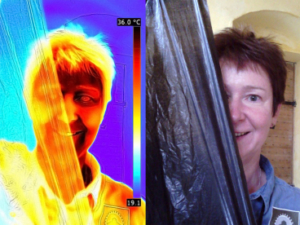Maureen Young
Conservation Scientist and Geologist
Image by Historic Environment Scotland
- BORN 1962, Paisley, Scotland, UK
- WORKED Dundee University, Geology Dept.; Robert Gordon University, Aberdeen, School of the Built Environment; Historic Environment Scotland, based in Edinburgh; The Engine Shed, Stirling (currently)
- HONOURS I have a BSc (Hons) in Geology from Glasgow University, an MSc in Geochemistry from Leeds University and a PhD from Robert Gordon University, Aberdeen on biological colonisation of building stone.
Artistic Connections
I got involved in this project when one of my colleagues told me there was this mad idea for celebrating superwomen of science and turning our conservation science data into music. I have no musical experience and had never conceived of such a thing, but the more I thought about it the more intrigued I became. Science data is full of themes, patterns and variations – the same concepts that musicians work with, and an enormously fertile area for what initially seemed like an outlandish collaboration.
MUSIC
Title: Salt Tears
Music: FRANCES M LYNCH in collaboration with Dr Maureen Young
Words by: Frances M Lynch, The Engine Shed Scientist’s data, Alexander Lindsay, John Willcock, Archibald 9th Earl of Argyll, Lady Anna Mackenzie
Additional Music: “Bonnie Isle O’ Whalsay” traditional tune for Lady Sophia Lindsay Scottish country dance created by Jean Attwood Alexander
Written in: 2018
For: Solo Mezzo, Baritone and Mixed Voices
Performed by: Margaret Cameron, Gwion Thomas and Frances M Lynch
First Performance: The Engine Shed, Stirling, September 18th 2018
The music is created from a number of different sources, but primarily from Data provided by Dr Maureen Young relating to the work she is involved with at the Argyle Tower in Edinburgh Castle.
The data is part of the work that Historic Environment Scotland carries out to conserve and restore their buildings,and involves Thermal Imaging, Moisture Analysis and Salt Analysis.
CLICK HERE to see a video of Thermal Image Art by Dr. Maureen Young
The story is that of Lady Sophia Lindsay who was the step-daughter of the 9th Earl of Argyll after whom the Tower is named. He is said to have been held beneath where this tower now stands during his various imprisonments at Edinburgh Castle.
The links with Stirling do not just come from the Engine Shed where the conservation scientists are based, but from Argyll’s Lodging, another HES property very close to Stirling Castle where the Earl lived with his second wife, Lady Anna Mackenzie and her daughters – one of whom was Sophia. Her courage in bringing a servant to the Tower who swapped places with Argyll, allowing him to go free, almost led to a public flogging, commuted to imprisonment. She suffered a great deal for Argyll and eventually, at a late stage in life, married his son Charles, but they had no offspring.
The composer acknowledges support from Creative Scotland, Historic Environment Scotland and the Scotland Foundation towards the writing and first performance of this score. The composition was also supported by Hope Scott Trust. Frances M Lynch is supported by PRS Foundation’s The Open Fund for Music Creators. The performance was also supported by the Ambache Charitable Trust.
CLICK HERE FOR THE TEXT FOR ‘SALT TEARS’
Title: Argyle Tower
Composed by: N5 and Higher Students from STIRLING HIGH SCHOOL
Written in: September 2018
For: 3 Female Voices, 3 Flutes, 2 Guitars, Bass Guitar, Piano, Keyboard, Vocal Percussion, Stone Percussion
Performed by: The Composers, Amy Bilsborough, Frances M Lynch, Margaret Cameron and Eleanor Logan
First Performed: The Engine Shed, September 18th 2018 (where it was recorded live)
In 1685 Archibald Campbell, 9th Earl of Argyll was executed at Edinburgh Castle. His story illuminates the life of his step-daughter, Lady Sophia Lindsay, who courageously freed him from Edinburgh Castle when he was first incarcerated, but found her rescue mission to have been in vain. Her story, which places her at Argyll’s Lodgings in Stirling with the Campbell family, is paralleled and inspired by the work of scientists working for Historic Environment Scotland, based at the Engine Shed in Stirling. They are engaged on conservation work at Argyle’s Tower in Edinburgh Castle which marks the place of the Earl’s imprisonment.
The students have taken elements of Sophia Lindsay’s story, interwoven with techniques used in our work which they translated into harmony and melody by applying number systems from the data onto musical scales. You will find references to Moisture Analysis (data showing where moisture is collecting in the stone), Chemical Elements from the Period Table, X-ray diffraction from salt analysis and Thermal Imaging which shows cold and warm spots in the vaulted room. They also used stone and slate samples to create rhythms, some traditional music referring to the Scottish Country Dance entitled Sophia Lindsay, and texts written by or about the protagonists in the story. Please go to the STIRLING HIGH SCHOOL page for more information.
RAPLOCH and RIVERSIDE Primary Schools also wrote based on our work but with the focus on our base in Stirling – The Engine Shed – as the focus of their story. For more information go to the school pages.
We acknowledge support for this project from Creative Scotland, Historic Environment Scotland and the Scotland Foundation towards the writing and first performance of this score. The composition was also supported by Hope Scott Trust. Frances M Lynch is supported by PRS Foundation’s The Open Fund for Music Creators. The performance was also supported by the Ambache Charitable Trust.
Education
I was always interested in science and from my earliest school years I had never considered any other career. I was fascinated by TV documentary series’ and scientific books – anything on a science, astronomy, biological or engineering theme – showing how the application of scientific techniques can reveal deep truths about the complex interactions in the world around us, making unexpected connections between seemingly unconnected things. Carl Sagan’s TV series and books were a particular inspiration and I was lucky enough to attend the series of Gifford Lectures he gave at Glasgow University in 1985 on the theme of “The search for who we are” where he gave a personal account of how he perceived the relationship between scientific knowledge and humanity’s place in the cosmos.
When I went to University I decided to specialise in Geology. The ‘stone’ connection eventually led me into the historic built environment and to my current position as a conservation scientist in Historic Environment Scotland, providing scientific support for colleagues who do the hands-on conservation work that preserves our heritage for future generations.
DID YOU KNOW?
I once stood on the head of President George Washington! I was part of the team laser scanning Mount Rushmore National Memorial in USA. We had to set up laser scanners on tripods on and around the president’s heads, so I also got to sit under Roosevelt’s chin.










